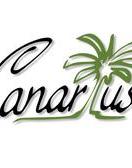The Canary Islands have a diverse agriculture, spread over different climates ranging from sunny coastal deserts to wet and cooler cloud forests. The main export crops are bananas and tomatoes, grown under shade cloths. Other monocultures of the past were Sugar Cane and Opuntia cacti, planted to obtain fruits and cochineals. Tropical fruits produced on a wide scale include avocado, mango, papaya and pineapple. A considerable collection of minor fruit crops is grown in smaller farms or family orchards: Chestnuts, Loquats, Guava and Coffee. Potatoes are widespread on the islands, both on a small family scale and on industrial scale.
Dry areas are planted with almonds, figs, wine grapes. New� tropical fruits include lychee and noni. Traditional agriculture still goes on in rural areas. Popular crops are potatoes and sweet potatoes, figs, and the exotic Ñame (Alocasia). Other related products of the Canarian fields are Bee-Honey, Palm-honey, and Sugar Cane-Honey. Animal breeding for meat, cheese and milk is performed by modern factories, mostly for the local maret. Traditional goat breeding still goes on in some areas of the islands.There is a thriving industry of ornamental plants and cut flowers. Exotic flowers are exported, such as Bird of paradise (Strelitzia), proteas and roses. Ornamental plants for use as indoor plants in mainland Europe include Kentia (Howea forsteriana), Dypsis lutescens, Chamaedorea elegans, Rhapis excelsa.

